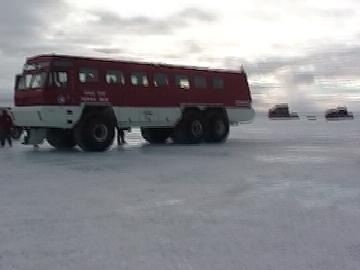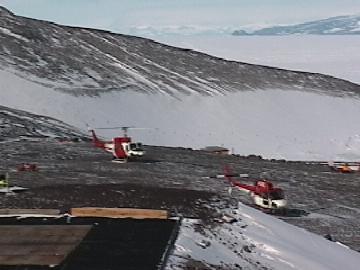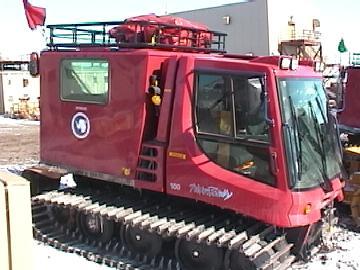
|
|
24 November, 2002
McMurdo
We arrived at McMurdo on a runway carved out of pure
ice late Friday night. I was a little anxious about
landing on ice, but it was actually one of the softer
landings I've experienced. I'm not sure how they stop
the plane. If they didn't reverse the engines I
believe it would drift for quite a while.
This is truly an amazing place. It is cool here;
daily highs in the upper teens, generally, but not
uncomfortable. One doesn't notice at first, but after
a while one realizes that nothing is alive here.
There are no plants, and the only animals we've seen
are large birds, called skuas, that feast on trash.
There aren't even plants in any of the buildings as
decorations. There are no children in McMurdo either.
It's hard as a teacher to adjust to not seeing anyone
under 18 years of age here.
What makes this place amazing is that it is a vibrant
community. Three major groups populate McMurdo,
scientists, support staff, and military. The
scientists are people like ANSMET, most of whom are
just passing through on their way to another site,
although, McMurdo has complete lab facilities for any
scientific group. The military is here to handle the
transport of goods and services to and from
Antarctica.
But, perhaps, the most amazing group is the support
staff. Over 1200 people work here to make sure that
the science can be done. The majority seem to be
young, in their 20's, but they range quite a bit in
age. They work all sorts of jobs from maintenace, to
the galley, to communications, and so forth. What's
more, is that most of these people will never leave
McMurdo, yet have worked very hard to get here. There
are numerous stories of medical doctors who worked
here as truck drivers just to see Antarctica. Or a
story of a woman who was a powerful lawyer who came
here and worked in the cafeteria just so she could see
Antarctica. Without the support staff, our expedition
would probably not be possible.
One of the first things we did in McMurdo was
familiarized ourselves with the town. To do this,
Dan, Dante, Cady, Diane, and I got certified to drive
the vehicles they use here. These are not normal
vehicles. They use jacked up 4WD Ford F-350's and 4WD
Econoline vans. We took one of the vans for "a spin"
and filled it up. Not even a fill-up is normal in
Antarctica. Everything is paid for by the NSF, so we
simply pumped the gas, and drove off. I kept checking
my mirror to see if we were being pursued.
There are constantly helo's (helicopters) flying in
and out of town, along with the C-130's that take off
and land right on the ice sheet. By mid-December,
that will stop as the ice begins to break up, and
they'll have to land on Ross Island, where McMurdo
sits.
In many ways, McMurdo reminds me of a mining town high
in the mountains. It's kind of like Leadville with
the climate and atmosphere of young people. McMurdo
has the basic requirements of a town with two places
to get "carbonated beverages," a coffee shop, and even
a bowling alley (one more than we have in Castle
Rock). It even has a chapel, the southernmost in the
world.
As I spend more time in McMurdo, I'm sure I'll write
more about the town. Yet, sometime, I'll have to talk
of our preparation for our upcoming field experience.

Ivan the terrabus ready to transport us from the landing strip to McMurdo.

C-130's on the ice.

Helo's ready to go.

Extreme machine (similar to a ride at the Antarctic Experience in Christchurch) Too bad I'm not qualified to drive this one!
Contact the TEA in the field at
.
If you cannot connect through your browser, copy the
TEA's e-mail address in the "To:" line of
your favorite e-mail package.
|
